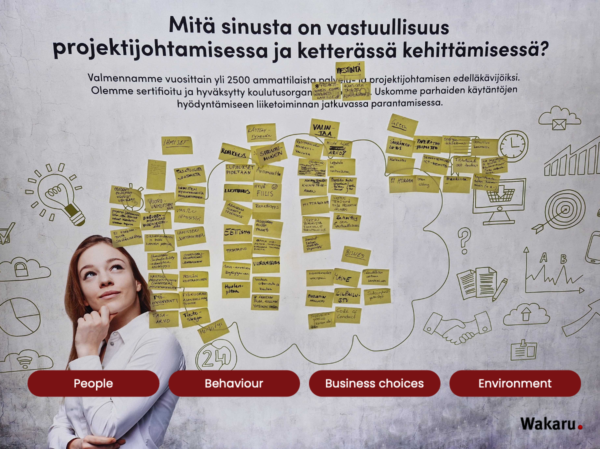
Projektipäivät, the biggest Project Management event in the Nordics is just around the corner again so our Partner, Wakaru, wanted to look back at the previous events and what they learned there. The event is organized by PRY, Project Professionals Finland and is the highlight of the year when it comes to project management and other professionals.
Wakaru discussed the responsibility of projects from different perspectives at 2022 event at their booth, where they asked participants for their views on the subject. Responsibility as a topic is incredibly broad, so they narrowed the focus to project management and agile development. Wakaru didn’t offer a “right” answer but gave participants the freedom to share what responsibility in this context means to them. The task turned out to be exciting, as many participants repeatedly came by throughout the days to see what issues had emerged and to share more of their views. Wakaru team themed the results and the main themes that emerged were people, behavior, business, and the environment.
They learned that the one most important thing that was repeated in different ways in the feedback was people. In project management it is easy to get blindsided with deadlines and processes. One might easily overlook the importance of the people in the project. It’s a no-brainer that you can easily finish a project so that everyone involved is burned out but if you want to finish in a way that the people involved are feeling motivated and energized – that’s true leadership! How to succeed in this then? Well, it all comes down to great leadership and people skills.
Projects Are Interactions Between People
In the responses, the responsibility of leadership was emphasized. Responsibility for workload, necessary task orientation, equality, and fair leadership—these are all issues that a project manager can influence through their actions but that affect the entire organization’s project culture. How many projects are initiated, and what types? Is the project portfolio management in order? Is attention paid to people’s well-being? Is project activity sustainable and responsible in this regard? Is “resources” always the corner of the project triangle that has to bend? The well-being of people involved in projects doesn’t typically get much attention when reading about responsibility. Usually, social and human impacts are considered in terms of the project’s stakeholders. Thus, the strong emphasis on these themes was both surprising and highly interesting. This is clearly an area for improvement, particularly in the context of an organization’s project culture.
Another factor that stood out from the feedback was psychological safety. It was mentioned to be very important that the people involved in a project felt that communication was transparent, the vibes were good, and that people were taking responsibility of their tasks and learning from possible mistakes. Also having the same rules for everyone in the project meant that people could rely on fair treatment, and no one gets free passes. The project manager has an important role in building the project culture and foundation, but they cannot succeed in this alone. The psychological safety is everyone’s issue and everyone in the project needs to be onboard with that. What kinds of behavior are accepted within the organization? Can people disagree constructively? And what about the ground rules for the project team? In only few projects are team agreements made where the jointly crafted ground rules for project practices are documented. However, in Wakaru events, working on these ground rules has always been found beneficial.
Integrating Responsibility into Project Initiation
Sustainable project management involves the planning, monitoring, and control of the project implementation and support processes while considering the environmental, economic, and social aspects of the life cycle of the project’s resources, processes, outputs, and impacts. Every organization always has more ideas and development needs than resources to carry them out. Not everything can be done, at least not immediately, so choices must be made. At the beginning of the project process, the best ideas and proposals are selected based on need and, above all, the potential benefits. The most useful ideas move from preparation to planning and then to execution. The benefits are realized through the outputs, and the outputs are achieved through projects.
However, merely defining benefits and planning the outputs related to them isn’t enough. Throughout the different stages of the project, all aspects of responsibility must be considered: economic, social, and environmental. Responsibility, particularly in the selection and planning of projects, must be taken into account. When Wakaru’ve coached organizations on their project models, they’ve noticed that responsibility is often not represented in the criteria for initiating a project.
The benefits of responsible project activities for an organization can be viewed from both economic and intangible perspectives. At best, responsibility is at the core of an organization’s strategy and is a competitive advantage. Economic benefits include, for example, better and more sustainable products, lower production costs, meaning increased value creation, increased sales revenues, reduced financial risks, and access to capital markets for responsible companies. Intangible benefits include competitive advantage resulting from the development of responsible products, meeting stakeholders’ responsibility expectations, the ability to retain the best employees, the company’s reputation and public image, and the building of trust between the company and its stakeholders.
Emphasis on Environmental Concerns
The responses mentioned responsible procurement, reducing travel, energy efficiency, and waste reduction. In general, these are concrete, practical actions that can be directly influenced in a project. Reducing travel, for example, is a clear decision made during the planning phase. What kinds of meetings will be held in this project? In the field of sustainable development, there is still much more to consider in projects. The United Nations has defined a total of 17 sustainable development goals, most of which are, of course, broader than what can be managed within a single project. However, these should be carefully considered at the portfolio level.
A version of this blog has been posted in Finnish at Wakaru website. Click here to read it.
Wakaru Oy
The professionals at Wakaru help their clients succeed with their extensive experience. They offer best practices, skill development plans, events, and technology services, using years of experience to support the continuous development of their clients’ business and personnel.
Their client companies are among the top 100 largest companies in Finland. Every year, they train nearly 3,000 professionals to become pioneers, and 4,500 professionals participate in their events. Wakaru is a certified and approved training organization (ATO). Wakaru’s customer satisfaction is high – nearly 100% of their clients would recommend their services to colleagues.

